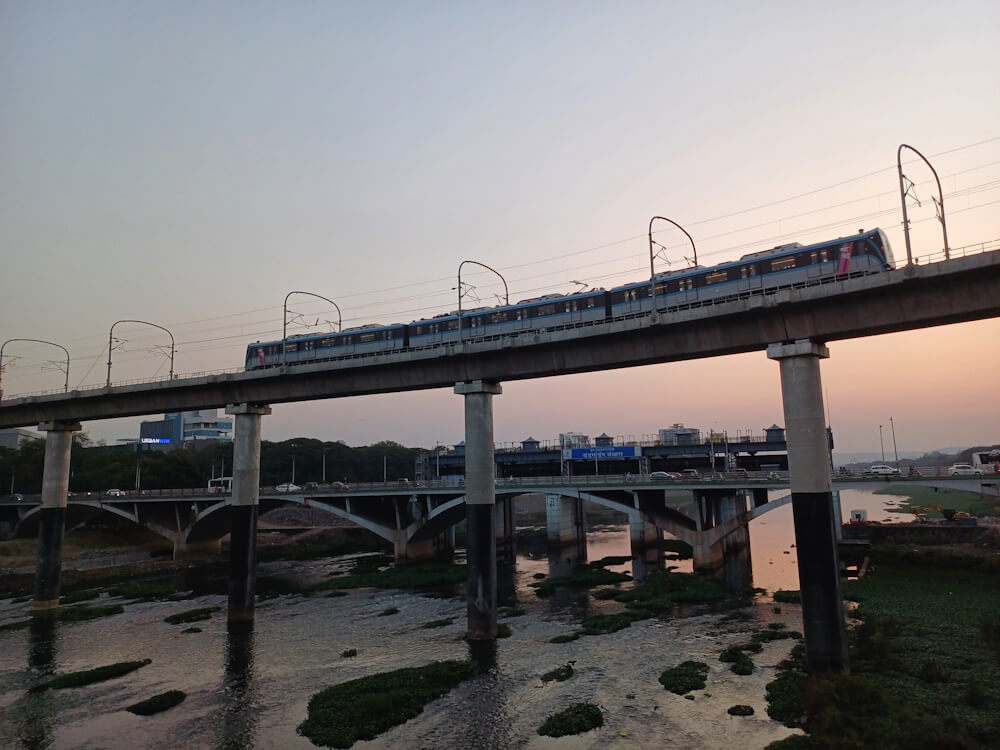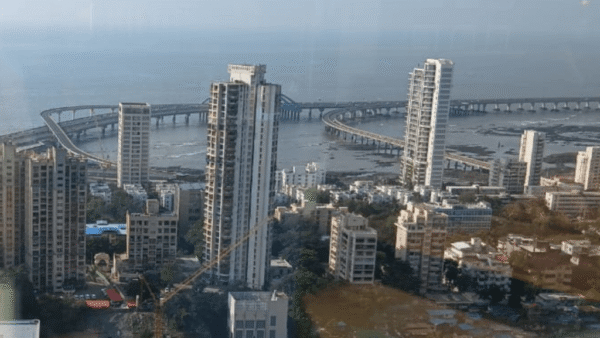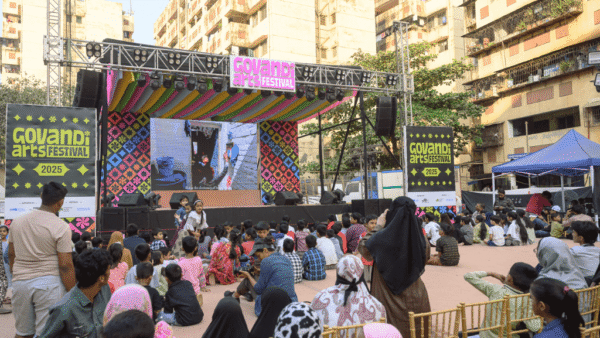More than once this monsoon, Pune struggled with massive flooding and waterlogging across areas as its roads turned into rivers and rainwater stayed in compounds and campuses. On June 8, Pune received 101 millimetres of rainfall in 24 hours, breaking its one-day record for June.[1] The monsoon battered the city on several days in July and August.[2] Every rainfall that led to flooding and waterlogging in the city once known as the ‘Queen of the Deccan’ had the social media abuzz with the question: why does Pune flood like never before?
There can be no simple or straightforward answers to the question, the city’s administration would have us believe. Yet, Pune like any rapidly growing city facing familiar challenges of traffic congestion, garbage piling up, sewage dumped into water bodies, water scarcity and flooding can look for answers across its changing skyline, on its expansion map, on its ecological atlas. It is, after all, nestled in the lap of the Sahyadri range in the Western Ghats.
Pune increasingly floods the way it does because its expansion in the past few years has meddled with – encroached upon – its rivers, streams, hills and forests. These natural flood mitigators have been mindlessly concretised. “In (the) city’s expansion, natural resources have been taken for granted as if they are there to be used, developed, exploited,” points out Dr Himanshu Kulkarni, scientist emeritus, Advanced Centre for Water Resources Development and Management.
The monsoon is not the only time that the impacts of rampant expansion show up. Punekars took to the social media this summer to wonder if their city would also go the way of Bengaluru as the southern fast-expanding city faced Day Zero this March, when the water demand exceeded the supply and city authorities shut down the municipal water system. Bengaluru, a city of a thousand lakes, has only around 200 left; most of them are polluted.
Like Bengaluru, Pune too has a lesson for fast-expanding cities – that development cannot mean reckless construction of buildings and infrastructure which chips away into natural areas within and surrounding a city. Pune shows other cities in a similar fast-expansion mode that the rivers and hills matter, that urbanisation has to be inclusive of ecology, that urban plans have to be nature-based. Pune is an example of how not to urbanise in an ecologically well-endowed city. This is why Pune’s story is important and instructive.
Ideal city to chaotic mess
Pune, around 150 kilometres from Mumbai, always boasted of a better quality of life. This had to do with its open expanse, green areas, cooler weather, and fresher air. Blessed with an abundance of nature, green hills dotting the city and rivers flowing through it, it was called a pensioner’s paradise. Its quality of life and liveability have attracted not only retirees but also students given its description as the ‘Oxford of the East’ and, lately, job seekers in manufacturing industries to software firms and multinationals.
Pune ranked second in the Quality of Living Index 2023 by Mercer, a global business consultancy. It has been topping the ease of living index in India often[3] but the ground reality is different, say residents like filmmaker Ishan Sadwelkar whose personal essay is here.
As Pune’s circumference widened to include old villages into city limits, and development meant building IT parks, educational institutions, large malls, swanky high-rises and office towers, the city’s skyline transformed in ways that might just be irreversible – the brown replaced nature’s green and blue. “Areas like Prabhat Road used to be lined with trees but the green cover has dwindled. The city expands every few years. First, they built Koregaon Park, then Kalyani Nagar was developed as its annexe, then Mundhwa became Kalyani Nagar’s annexe,” remarks environmentalist Sathya Natarajan who remembers old Pune. The city’s boundaries have expanded to merge Aundh, Baner, Wakad, Bavdhan, Warje, once villages, into its limits.
Pune’s population multiplied from 1.7 million in 1991 to 3.2 million in 2011[4] but the past decade has seen an explosion. It is now estimated at 7.3 million. These figures include the urban agglomerations beyond the old city.[5] Long-time resident and environmentalist Sarang Yadwadkar calls the city “obese” where growth cannot be called that anymore.
This does not mean that cities cannot grow or expand. It is the character or kind of that expansion that is being questioned, the cost at which at which this expansion has been done, and whether sooner or later, the expanded city pays the ecological price for it.
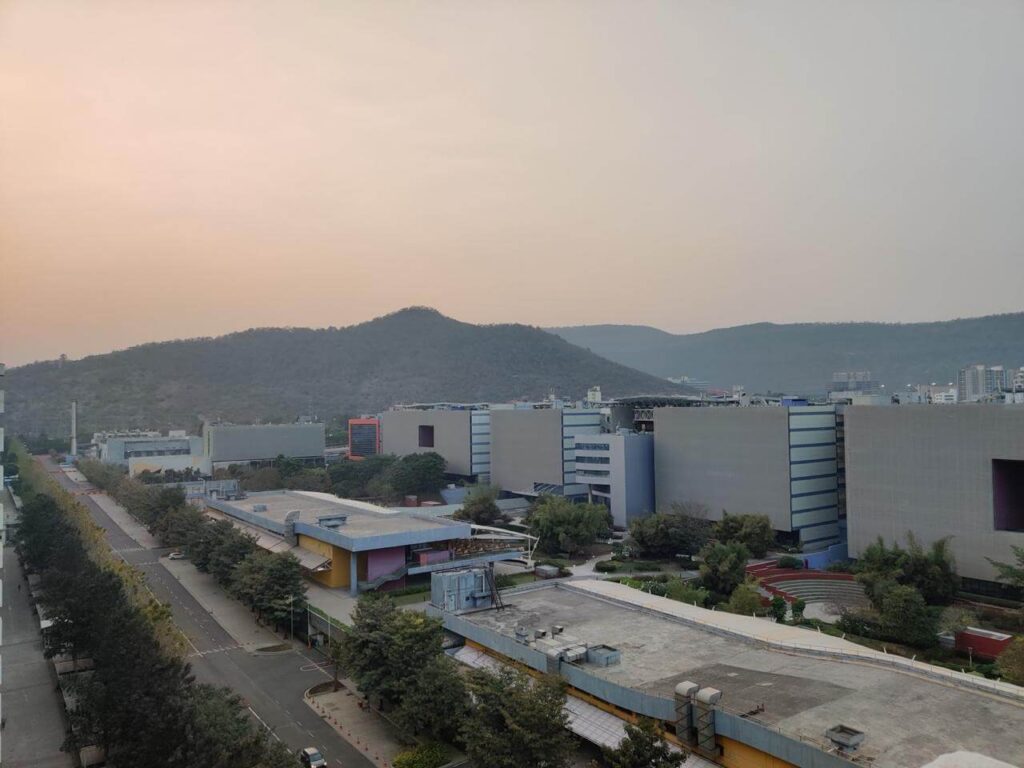
Photo: Wikimedia Commons
For example, the sleepy village of Hinjewadi on Pune’s outskirts is now a sought-after location known as its IT hub or Silicon Valley. In the transformation, Hinjewadi’s ecosystems – aquatic flows and streams, hillocks, biodiversity – have disappeared. Studies found that in the 1992-2013 expansion of the city, the associated land use and land cover change showed that most urban land was either grassland or agricultural land.[6] This would have consequences, perhaps of flooding.
Well-known birder Ranjeet Rane told Question of Cities that although Pune lies in a rain shadow region, it was demarcated fallow land and opened for development, affecting flora and fauna that’s unique to grasslands. “A lot of fallow land seems barren but is the habitat of various species. Afforestation drives happening here are detrimental to the environment. Wherever the land use patterns change, weeds such as lantana spread affecting the biodiversity of the area. Migratory birds are dwindling.”
There has been a significant increase in Pune’s urban sprawl. The city, in 1991, was about 54.3 square kilometres which increased at an annual average rate of 13.8 percent to become 220.6 square kilometres in 2001 – a massive rise. It then grew at an annual average rate of 7.5 percent to be around 460 square kilometres in 2011,[7] and would have clocked similar unsustainable growth in the past decade which saw a rapid rise in its sprawl.
After 2012-13, the Pune Municipal Corporation (PMC) brought 34 villages under its jurisdiction (23 were in 2017, 11 in 2021) and included them in Pune Master Plan 2041. Baner and Balewadi, now sought-after locations for high-end complexes and gated communities, were merged earlier. Before that, Baner used to boast of guava orchards, agricultural fields and lush green hills. Both now bear no signs of these but have concrete structures, pothole-ridden roads, severe water scarcity and flooding.[8]
Changed topography and ecology loss
The amalgamations have been of ecologically-rich non-urban areas which were once resplendent with streams, hills and an astounding biodiversity of species. How these would be protected or what needed protection was not deliberated in the corridors of power in Pune even as its civic limits expanded. This is where, one could say, Pune lost the game; expansion meant concretised development of newer areas without a thought for its natural ecology.
Where were the species supposed to go? Where would the water flowing down the hills, slowed down by the slopes, collect? What would happen to temperatures and soil and groundwater water when thousands of trees had been chopped for ‘development’ that mostly meant buildings-roads-metros? The non-ecological approach is evident not only in Pune’s present but also in its future – in the master plan.
The Pune Master Plan 2041 mentions well-planned infrastructure and sustainable practices, providing for 26 town planning schemes, 10 metro rail routes, two ring roads (123 kilometres and 173 kilometres), 59 public housing projects, 152.19-kilometre Pune-Nashik semi high-speed rail, 12 logistics hubs, and nine truck terminals, among other things.[9] Where was sustainability included, how much green was protected, how many water bodies preserved is anybody’s guess.
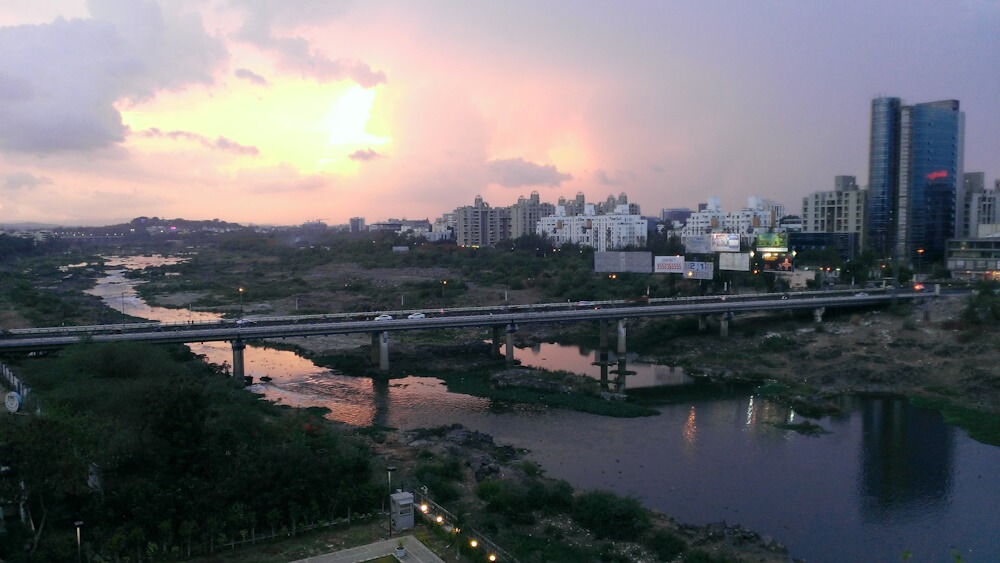
Photo: Mack Male/Wikimedia Commons
This, unfortunately, is not an exception but the mainstream approach to urbanisation itself – to plan for ‘development’ without factoring in the ecology of an area, its natural vegetation and forest cover, its stream and water bodies, its flow of life. It is not difficult to say that such urbanisation would not be sustainable. This is being repeated in villages like Lohegaon, Mundhwa, Phursungi, Uruli Devachi, Hadapsar, Ambegaon Khurd, Ambegaon Budruk, Undri, Dhayari, Shivane, and Uttamnagar which were amalgamated into the PMC in 2017 where construction has been in full swing unmindful of their natural areas.[10]
Pune’s rivers – the Mula, Mutha, Pawana, Ramnadi and Devnadi – originate in the Sahyadri range and have a steep gradient till the city after which it is lower. This makes for fast-rising flood levels especially if natural pathways of water are blocked. “Water bodies are being built upon, the city’s ridges and hills are being destroyed. The invisible portions of the landscape like the natural recharge areas of aquifers below have never been acknowledged,” said Dr Kulkarni, “Nobody recognised them as aquifers. This is the overall story of Pune’s growth.”
The steep rise in Pune’s population has meant a rise in sewage, most of which flows into the rivers untreated. These have become its sewers. Instead of cleaning and rejuvenating them, the PMC went all out with the controversial riverfront development project at nearly Rs 5,500 crore which will create lakhs of square metres of real estate. Read about it here. The project has meant large-scale cutting of trees. Pune lost 27,000 trees in the last three years.[11]
According to a Survey of India report, more than 32 percent of streams in Pune vanished between 1971 and 2015.[12]Dr Shrikant Gabale, urban geomorphologist, found around 40 percent of the nearly 3,000 streams in Pune disappeared in the last 30 years. “This results in decreased water discharge pathways, causing further challenges in managing stormwater,” he said.[13]
With such massive ecological changes reducing the capacity of the land to handle heat and rainfall, it should not surprise anyone that Pune now has record-breaking summer temperatures and flooding which are slated to worsen with climate change impact.
What must Pune do?
“Pune must avoid vertical growth beyond its limit,” said Professor Amitav Mallik of the Pune International Centre. “The tendency for vertical growth means new buildings are 20-25 floors high. The taller the building, the deeper the pit dug which completely upsets the groundwater system and its entire flow beyond the building site.” Mallik’s radical idea, which he will propose to the Maharashtra government, is to restrict buildings to seven floors. “Even if they are down to 15 floors from 25 floors now, it will benefit Pune. The newly-merged villages, for example, can have horizontal development.”
This may well be a solution for other cities too. But merely restricting building height is not sufficient – there must be a paradigm shift to make urban planning and construction nature-based by factoring in the elements of ecology into the master plan, and strictly implementing it.
Tree planting in the once-green areas has also been offered as a salve but neither this nor stopping tree cutting will help much, says Aneeta Gokhale Benninger, geographer-turned-planner who co-founded the Centre for Development Studies and Activities. “We need to ensure the regeneration of existing forest, creation of additional forest, and enforce a 60:40 ratio of built environment to natural environment.”
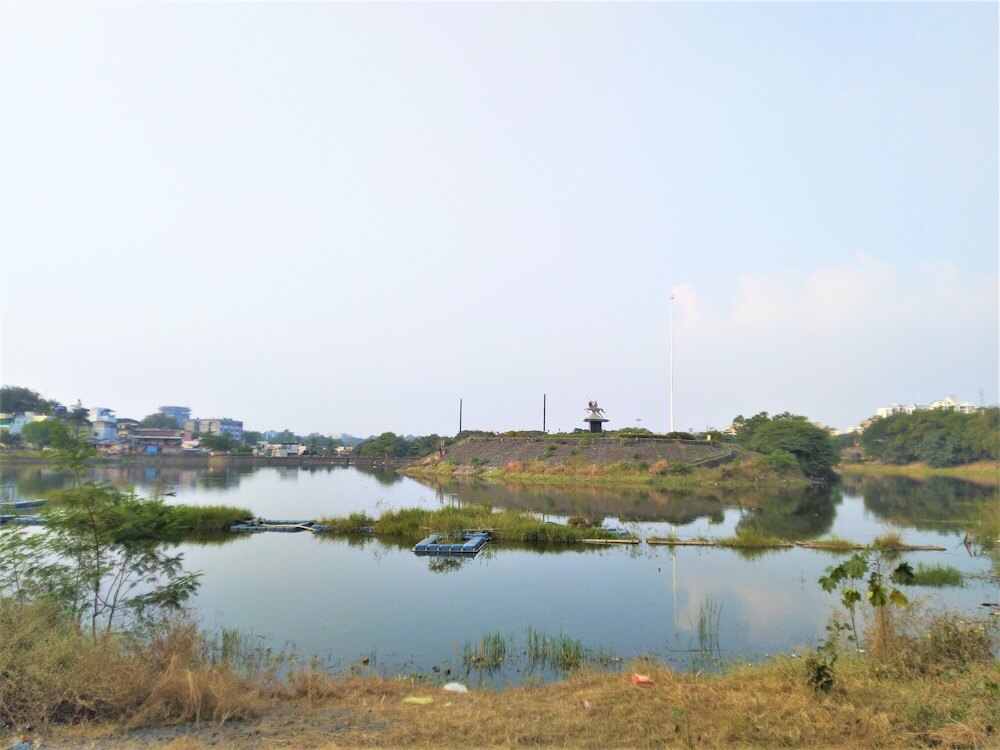
Photo: Wikimedia Commons
The built environment is not just constructed buildings but also open spaces such as parks, gardens, playgrounds, as well as communication and road networks, amenities such as health, education, museums. “The most critical decisions in the creation of a built environment are population densities and dwelling densities,” she said.
Encroachments of all kinds, shrinkage of marshy areas due to the channelisation of rivers, dumping of garbage and construction material, the introduction of invasive species, and pollution all demand differing responses from a host of authorities. Even stopping the dumping of debris along the Mutha and Mula rivers would allow some of the flora-fauna to renew.
Dr Kulkarni suggests the need to apply the precautionary principle when it comes to natural resources, that saving the natural heritage is itself providing for a sustainable future. This calls for a large amount of regulation in various areas assigning environmental or ecological value to natural resources and then enforcing the regulations while construction permits are given.
The dangerous consequences of building on hydrological lifelines should be recognised and be made part of the planning discussions, according to urban geomorphologist Dr Gabale. The plans must involve the local community in every place who know the lay of the land. This would help determine better stormwater management, natural anti-flood systems, managing floodplains, collecting rainwater, and so on.
The way to prepare Pune for floods is not to infuse more engineering solutions alone but to return to its natural ecology too, to respect ecology, to build with it or around it. As environmentalist Sarang Yadwadkar, fighting many cases in the National Green Tribunal and High Court, put it: “We have our right on plateaus. Through rivers, only wind and water can flow. On hills, only trees can survive. But we are encroaching on all sides, in the hills as well as in the valleys.”
Pune’s authorities and planners can start by listening to its environmentalists who can convince them why preserving and renewing the city’s ecology is its best bet against climate change impacts; other measures are just quick-fixes. As well-known environmental economist Dr Pavan Sukhdev remarked at the Darryl D’monte Memorial lecture last year: Nature does not send us an invoice.
With inputs from multimedia journalist Jashvitha Dhagey
Shobha Surin, currently based in Bhubaneswar, is a journalist with 20 years of experience in newsrooms in Mumbai. An Associate Editor at Question of Cities, she is concerned about Climate Change and is learning about sustainable development.
Cover photo: Wikimedia Commons

